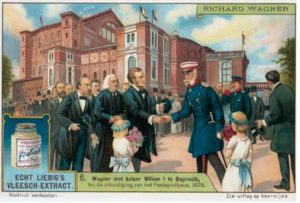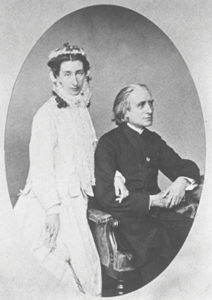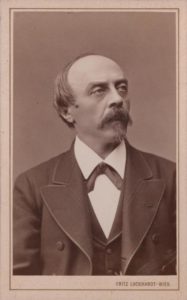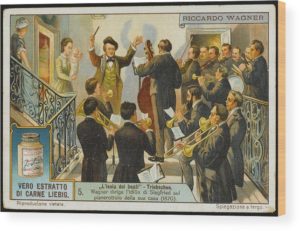
Yesterday’s Music History Monday marked the 144th anniversary of the premiere of Richard Wagner’s music drama Götterdämmerung (“The Twilight of the Gods), the fourth and final installment of his epic tetralogy The Ring of the Nibelungs. As we properly observed yesterday, Wagner’s Ring was and remains the greatest single undertaking in the long history of Western music.
We read – here and there – that “Wagner wrote almost no instrumental music.” This is a most misleading statement, as he was a brilliant composer for orchestra and did indeed compose a significant body of orchestral music. However, it just so happens that the great bulk of that orchestral music was incorporated into his stage works as overtures, entr’actes, interludes, codas, etc. Let’s rephrase that just-quoted statement to read this way: “in his maturity, Wagner (1813-1883) wrote very few self-standing, exclusively instrumental compositions, the most famous of which is his Siegfried Idyll of 1870.”
Siegfried Idyll is an exquisite work, with a fabulous back-story, and after all, how often do we get to hear and revel in a Wagnerian opus that runs but 20 minutes from beginning to end? So let’s do it!
But first, let us contemplate good birth dates and bad birth dates.
In terms of competing events, most birth dates are okay-to-good. I was born on Easter Sunday, April 18, 1954. It is, I suppose, as good a date as any, and while I must share my birthday with a number of significant historical events – the laying of the cornerstone at Rome’s St. Peter’s Basilica in 1506; Paul Revere’s ride in 1775; the San Francisco earthquake in 1906; Jimmy Doolittle’s raid on Tokyo in 1942; and the death of Albert Einstein in 1955 – none of these events ever got in the way of celebrating my birthday. Ditto my daughter Lily, who was born on October 14, 2006. Granted, she shares her birthday with William Penn (1644), Dwight D, Eisenhower (1890), E.E. Cummings (1894), Ralph Lauren (1939), Joe Girardi (1964), and Usher (1978), but really, do we care? In our house, October 14 is about Lillian Patricia, period.
My father was born of Cinco de Mayo (May 5) 1925; my brother Steve on St. Patrick’s Day (March 17), 1956; my son Samuel on February 13 (the day before Valentine’s Day), 1990. These are excellent birth dates, each of which comes with a built-in license-to-party. Vis-à-vis birthday parties, the birthdays of my daughter Rachel (July 9, 1986) and son Daniel (November 24) are not-so-good. Kids are away during the summer when Rachel was born, and Danny’s birthday always falls within a few days of Thanksgiving (thus, his birthday parties take place after the holidays, in January or February.)
Finally, there are the truly rotten birth dates. The worst of all has got to be February 29; like the Olympic Games and U.S. Presidential elections, one (technically) gets to mark one’s birth but every four years. A cosmic rip off to my mind. Such was the fate of Gioachino Rossini and Dinah Shore (as well the serial killers Aileen Wuornos and Richard Ramirez; which, as company goes, is a bit creepy).
The second-worst birth date? Christmas day, December 25. For someone born into a family that observes Christmas, a Christmas birthday is a total swindle, as inevitably Christmas and birthday get rolled into a single celebration, the whole usually lesser than the parts. As for gifts, well, a December 25th birthday is (or so I’ve been told) is a catastrophe. (How many times have these unfortunate celebrants heard the line, “we decided to give you one big present this year”? Sure. Right.) Among the many good people born on December 25 are Clara Barton, Humphrey Bogart, Jimmy Buffett, Conrad Hilton, Annie Lennox, Sissy Spacek, Kenny Stabler, and Justin Trudeau.

To that august list of Yule babies let us now add Cosima Liszt von Bülow Wagner, who was born late on Christmas eve of 1837 (but always celebrated her birthday on Christmas day) and died 92-plus years later, in April of 1930. The illegitimate daughter of the great Franz Liszt and his Parisian socialite mistress Marie d’Agoult, Cosima’s early life reads like a Victorian disaster novel of never-ending trials and tribulations.
(For details of her life and relationship with Wagner see Music History Monday for December 24, 2018.)

Cosima was born goofy: tall, ungainly, thin as a rail, with an impossibly wide mouth and a nose the size of a 1967 Lincoln Continental (a car also-known-as a “land yacht”). Her sister Blandine and her brother Daniel called her “the ugly duckling” and “the goose”; admittedly unkind but not inaccurate. But Cosima was smart and talented, and she emerged from a childhood filled with parental neglect, custody battles, and an excessively harsh private education as a hard, cruel, supremely ambitious young woman. She lived a time when a woman’s ambitions were most easily fulfilled through the men in her life, and oh what men did Cosima choose to marry!
Her first husband was her father Franz Liszt’s star student: a brilliant, world-class pianist and conductor named Hans von Bülow. They married in 1857 when Cosima was 19 and Hans was 27.

Von Bülow was passionate about the music of Richard Wagner; among many other of his services to Wagner, he conducted the premieres of Tristan und Isolde in 1865 and Die Meistersinger von Nürnberg in 1868. Richard Wagner showed his gratitude to von Bülow by becoming passionate about von Bülow’s young wife, Cosima, who was 24 years Wagner’s junior. Cosima and Richard began their affair in 1863; they had three children together, and yet – incredibly – von Bülow seems not to have known what was going on until 1868, when Cosima finally walked out on him. With her kids in tow, she moved into Wagner’s rental house, a chalet called the Villa Tribschen on Lake Lucerne in Switzerland. It was only then that she asked her gob-smacked husband for a divorce, and it was only then that the poor, cuckolded Hans von Bülow became fully aware of something that everyone else on the planet already knew: that his adored wife Cosima and his dearest friend Richard Wagner had been playing him for a sucker for years.
The divorce was granted July 18, 1870 and the lovebirds were married 5 weeks later, in Lucerne Switzerland, on August 25. So, come Christmas Day exactly four months later – their first Christmas together as husband and wife – Richard and Cosima had much to celebrate. And celebrate in style they did.

Cosima woke up that morning to the sound of music coming from outside her bedroom. Pulling on a robe, she went out into the hall where she, the children, and their house guest – the philosopher Friedrich Nietzsche, no less – were greeted by an astonishing sight: thirteen performing musicians arrayed on the stair case (including the great conductor Hans Richter, who was playing the trumpet) with Richard Wagner conducting. They were playing a piece of music custom-composed by Wagner for the occasion, which he had entitled Triebschen Idyll with Fidi’s birdsong and the orange sunrise, as symphonic birthday greeting. Presented to his Cosima by her Richard, 1870. (“Fidi” was the nickname for Cosima and Richard’s 18-month-old son Siegfried. The “birdsong” and “sunrise” references refer to the sounds and color of the sky that accompanied Siegfried’s birth, early in the morning on June 6, 1869.) …
Continue reading, and see the prescribed recording, only on Patreon!
Become a Patron!